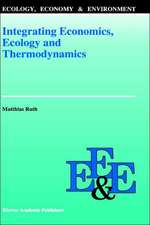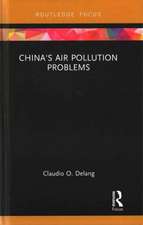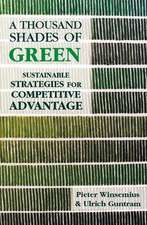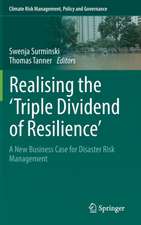Modeling Dynamic Economic Systems: Modeling Dynamic Systems
Autor Matthias Ruth, Bruce Hannonen Limba Engleză Hardback – 9 feb 2012
| Toate formatele și edițiile | Preț | Express |
|---|---|---|
| Paperback (1) | 490.62 lei 6-8 săpt. | |
| Springer – 9 feb 2012 | 490.62 lei 6-8 săpt. | |
| Hardback (1) | 590.95 lei 6-8 săpt. | |
| Springer – 9 feb 2012 | 590.95 lei 6-8 săpt. |
Preț: 590.95 lei
Preț vechi: 695.24 lei
-15% Nou
Puncte Express: 886
Preț estimativ în valută:
113.08€ • 118.38$ • 93.56£
113.08€ • 118.38$ • 93.56£
Carte tipărită la comandă
Livrare economică 05-19 aprilie
Preluare comenzi: 021 569.72.76
Specificații
ISBN-13: 9781461422082
ISBN-10: 1461422086
Pagini: 343
Ilustrații: XVII, 326 p.
Dimensiuni: 155 x 235 x 25 mm
Greutate: 0.61 kg
Ediția:2nd ed. 2012
Editura: Springer
Colecția Springer
Seria Modeling Dynamic Systems
Locul publicării:New York, NY, United States
ISBN-10: 1461422086
Pagini: 343
Ilustrații: XVII, 326 p.
Dimensiuni: 155 x 235 x 25 mm
Greutate: 0.61 kg
Ediția:2nd ed. 2012
Editura: Springer
Colecția Springer
Seria Modeling Dynamic Systems
Locul publicării:New York, NY, United States
Public țintă
GraduateCuprins
Foreword.- Preface.- Notation.- Part I: Introduction.- Modeling Dynamic Systems.- Disaggregation of Stocks.- Part II: Methods for Dynamic Modeling.- System Boundaries in Space and Time.- Scheduling Flows.- Positive Feedback in the Economy.- Derivatives and Lags.- Part III: Microeconomic Models of Firms.- Introduction to Modeling Economic Processes.- Substitution of Inputs in Production.- Time Value.- Opportunity Cost.- The Profit-Maximizing Competitive Firm.- The Profit-Maximizing Monopoly.- Monopolistic Collusion.- Quasi-Competitive Equilibrium.- Modeling Economic Games.- Part IV: Modeling Optimal Use of Nonrenewable Resources.- Competitive Scarcity.- Competitive Scarcity with Substitution.- Competitive Scarcity with Cost Dependent on Production Rate and Resource Size.- Competitive Scarcity with Technical Change.- Competitive Scarcity with Exploration.- Monopoly Scarcity.- Monopoly Scarcity with Variable Interest Rate.- Monopoly Scarcity with Cost Dependent on Production Rate and Resource Size.- Part V: Modeling Optimal Use of Renewable Resources.- Optimal Timber Harvest.- Managing Open Access Resources.- Optimal Harvest from Fisheries.- Spatial Fishery Model.- Part VI: Chaos in Economic Models.- Preference Cycles and Chaos.- Nonmonotonic Demand and Supply Curves.- Price Expectation and Production Lags.- Chaos in Macroeconomic Models.- Part VII: Conclusion.- Building a Modeling Community.- References.- Index.
Textul de pe ultima copertă
Economists model the ways in which humans meet their needs using given endowments of resources and technologies. This book explores the dynamic processes in economic systems, concentrating on the extraction of resources that are required to meet economic needs.
Using the STELLA® software, Modeling Dynamic Economic Systems applies methods of computer modeling to a wide range of real-world economic phenomena, demonstrating how to make informed decisions about economic performance and environmental quality. Sections of the book cover: methods for dynamic modeling economics with special emphasis on the microeconomic models of firms, modeling optimal use of both nonrenewable and renewable resources, and chaos in economic models.
The book does not require a substantial background in mathematics or computer science and encourages all students and scholars to actively incorporate modeling into their education and research. A save-disabled version of STELLA and the computer models of this book are available at www.iseesystems.com/modelingeconomicsystems.
About the Authors
Matthias Ruth is Roy F. Weston Chair in Natural Economics at the University of Maryland, College Park.
Bruce Hannon is Jubilee Professor (Emeritus) of Liberal Arts and Sciences at the University of Illinois, Urbana-Champaign.
About the Series
The availability of powerful, intuitive software for developing and running computer models of real-world phenomena promisesa revolution in studying, teaching and thinking about complex problems that range from the functioning of a cell to that of an ecosystem to that of a national economy. The books in the series Modeling Dynamic Systems promote the spread of “systems thinking” by integrating state-of-the-art modeling techniques with the theories and concepts of specific disciplines or interdisciplinary topics. The unifying theme of the series is the ease, power, and transparency of model building.
Using the STELLA® software, Modeling Dynamic Economic Systems applies methods of computer modeling to a wide range of real-world economic phenomena, demonstrating how to make informed decisions about economic performance and environmental quality. Sections of the book cover: methods for dynamic modeling economics with special emphasis on the microeconomic models of firms, modeling optimal use of both nonrenewable and renewable resources, and chaos in economic models.
The book does not require a substantial background in mathematics or computer science and encourages all students and scholars to actively incorporate modeling into their education and research. A save-disabled version of STELLA and the computer models of this book are available at www.iseesystems.com/modelingeconomicsystems.
About the Authors
Matthias Ruth is Roy F. Weston Chair in Natural Economics at the University of Maryland, College Park.
Bruce Hannon is Jubilee Professor (Emeritus) of Liberal Arts and Sciences at the University of Illinois, Urbana-Champaign.
About the Series
The availability of powerful, intuitive software for developing and running computer models of real-world phenomena promisesa revolution in studying, teaching and thinking about complex problems that range from the functioning of a cell to that of an ecosystem to that of a national economy. The books in the series Modeling Dynamic Systems promote the spread of “systems thinking” by integrating state-of-the-art modeling techniques with the theories and concepts of specific disciplines or interdisciplinary topics. The unifying theme of the series is the ease, power, and transparency of model building.
Caracteristici
Models in this book were created using STELLA software The authors have updated this book so that it is more accessible to students studying model development This book models and analyzes the dynamics characteristic of economic processes and human-environment interactions Includes supplementary material: sn.pub/extras






































